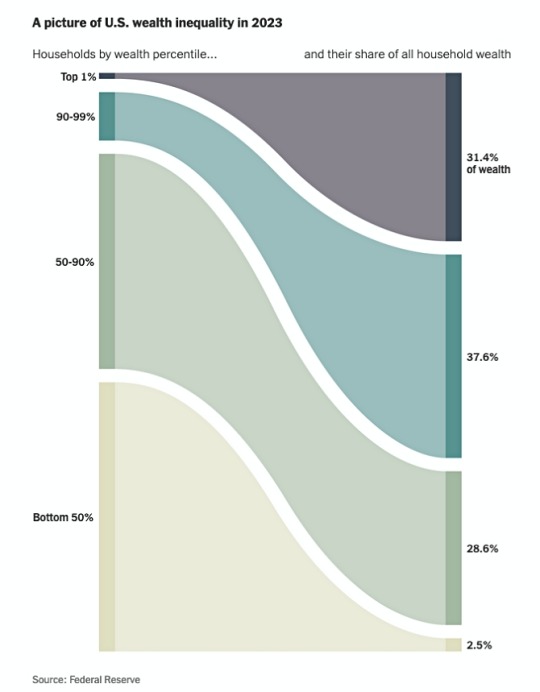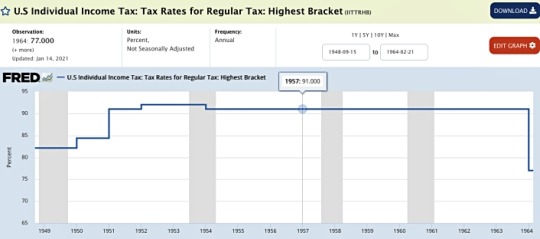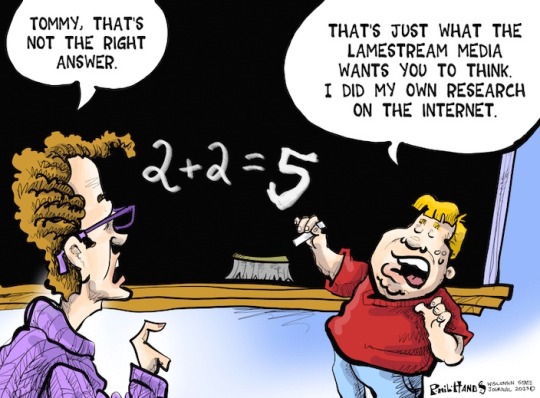#VOODOO ECONOMICS
Photo

104 notes
·
View notes
Text

^^^ This is why people think things are getting worse. 1% of the US population owns 31.4% of the nation's wealth.
This is the result of massive tax breaks for the filthy rich which began under Republican Ronald Reagan in the early 1980s, were boosted twice by Republican George W. Bush in the 2000s, and got a big boost under Republican billionaire Donald Trump.
David Leonhardt at the New York Times writes...
The simplest explanation for the shift is that the old economic approach hasn’t worked very well for most Americans. Starting in the 1980s, the U.S. moved toward an economic policy that’s variously described as laissez-faire, neoliberal or market-friendly. It involved much lower taxes for the wealthy, less regulation of business, an expansion of global trade, a crackdown on labor unions and an acceptance of very large corporations.
The people selling this policy — like Milton Friedman, a Nobel laureate in economics — promised that it would bring prosperity for all. It has not.
Incomes for the bottom 90 percent of workers, as ranked by their earnings, have trailed economic growth, and wealth inequality has soared. For years, Americans have told pollsters that they were unhappy with the country’s direction. Perhaps most starkly, the U.S. now has the lowest life expectancy of any affluent country; in 1980, American life expectancy was typical.
Conventional wisdom rarely changes quickly. Friedman and his fellow laissez-faire intellectuals spent decades on the fringes, before the 1970s oil crisis and other economic problems caused many Americans to embrace their approach. But conventional wisdom can change eventually. And after decades of unmet promises about the benefits of a neoliberal economy, more people have grown skeptical of it recently.
Massive tax breaks for the filthy rich as a means of boosting economic growth for all was once regarded as fringe economics – until Ronald Reagan took office. Even the man who became Reagan's vice president referred to such a policy in the 1980 primaries as "voodoo economics" – but to no avail. It has largely overshadowed economic policy for the past 40+ years.
There were only two exceptions. In 1993 when Democrat Bill Clinton raised taxes on the filthy rich. The economy soared and the 1990s became the most prosperous decade since the 1950s. And in 2013 Democrat Barack Obama let the Bush tax breaks expire. Sadly, Trump and the then GOP majorities on Capitol brought back the Bush tax breaks in 2017 and have been ironically blaming poor people for the subsequent rise in the national debt.
As president, Trump often contradicted his own populist rhetoric. (His one big piece of legislation was a tax cut that mostly benefited the rich.)
There needs to be a repeal of the Reagan-Bush-Trump tax giveaways to billionaires like Elon Musk.
One stat which Republicans don't like hearing is that in the mid 1950s, the highest federal income tax rate was 91%.

Republicans are nostalgic about some stuff about the 1950s like Jim Crow laws and suppression of women and gays. But they don't talk about the federal tax rate on the filthy rich which helped build the Interstate Highway System and provided low cost college education to the masses.
We don't need to go back to a rate of 91% for the Musks, Trumps, and Zuckerbergs. But just under half that rate would dramatically restore economic balance in this country. And the ONLY way to get there is to keep promoting growing Democratic majorities in Congress and electing Democratic presidents. Votes for third party losers are about as helpful as used toilet paper.
#usa#wealth inequality#income inequality#republican tax breaks for the filthy rich#voodoo economics#ronald reagan#george w. bush#donald trump#billionaires are the main beneficiaries of republican rule#prosperity = higher taxes on the rich#vote blue no matter who#election 2024
13 notes
·
View notes
Text
Financially Good Omens: The Nice and Accurate Prophecies of Agnes Nutter, Voodoo Economist
A new adaptation of Good Omens, except all the predictions are about Reaganomics. Also, the devil wins in the end.
#bad idea#movie pitch#pitch and moan#good omens#terry pratchett#neil gaiman#prediction#reaganomics#voodoo economics#supply side economics#finace#economics#horror#fantasy#comedy#adaptation
16 notes
·
View notes
Link
If the Republicans want to win back the White House in 2024, they could learn a lot from the 1947 Christmas classic Miracle on 34th Street. Read detail.
0 notes
Photo


The drugs didn’t end up in the cities on accident.
(via Reagan: PUSHER Baseball ¾ Sleeve T-Shirt by KBwiththeTees)
#Ronald Regan is the devil#Ronald Regan was the devil#Reagnomics#voodoo economics#Cocaine imports#contras#nicaragua#zero tolerance#war on drugs
1 note
·
View note
Note
Susan Taxpayer crashed my laptop
good
100 notes
·
View notes
Text

me, @catboybeebop, & @ricochete29 circa april 1st 2024
25 notes
·
View notes
Text
The Skibidi Toilet School of Economics.
It’s like trickle down economics, but even WORSE!
Hyper neoliberalism!
Followed by an Uberinflation death spiral!
And they’ll still blame it on socialism!
Because they’re STUPID!
It’s basically capitalism
#dougie rambles#personal stuff#economics#my poor attempt at a joke#political crap#what#no context#finance#skibidi toilet#voodoo#trickle down economics#it doesn’t work#anti capitalism#leftism#shitpost#fucking morons
11 notes
·
View notes
Note
if V1 "the robot" Ultrakill was an animal what animal would it be? please its urgent
fucked up sort of damselfly. maybe mosquito
10 notes
·
View notes
Note
trick or treat :D
the entire album of Alternia
8 notes
·
View notes
Text

Happy Birthday @voodoo-economics !!!!! :33333
(or maybe i should say....... vappy birthday x3)
129 notes
·
View notes
Photo

MAGA math – in a red state near you. This may be how “voodoo economics” got its start.
The quality of education is going to suffer in states like Florida and Texas where teachers have to deal with book censorship and other heavy-handed political intrusions into their classrooms.
If you’re starting out as a teacher, would you want to become a mouthpiece for Ron DeSantis or Greg Abbott?
#red states#republicans#maga math#quality of education#book censorship#texas#florida#ron desantis#greg abbott#voodoo economics#phil hands
4 notes
·
View notes
Note
Considering his background and the era he lived in... it is entirely possible for Alastor's mother to have been lynched. Sadly, it may even have been likely if we followed the theory that beesrned his Voodoo abilities from her. That or some other terrible fate, there was no end of horrible things that could happen to a young black woman in the 1920s, especially one in an abusive relationship to a white man according to old life streams.
Oh, man. This is a really interesting topic and honestly sent me spiraling down a Google rabbit hole because there's so much interesting historical background that would inform it and there are a LOT of overlaps.
First, there's the topic of black women being lynched - which is often largely left out of the conversation about lynching.
The rise of lynching after Reconstruction was primarily a response to white people feeling threatened because of gains by black people - especially black men - were making (voting rights, economic competition, running for office, labor organizers) + stereotypes about black men being violent and sexual predators. So, the majority of lynching victims (there's a good list here) were men.
Only around 3-4% of lynching victims were female by official reports. (But take that statistic with a grain of salt because it doesn't mean black women weren't being killed and brutalized - it just wasn't often recognized as a lynching.)
And that has an interesting tie into Voodoo in New Orleans because upper-class white women were joining ceremonies and Voodoo was used to stoke the fires of white supremacy. So, it goes back to those same ideas about lynching to "protect white women"
In an 1895 book, journalist and judge Henry Castellanos recalled an antebellum raid on a ritual:
Blacks and whites were circling round promiscuously, writhing in muscular contractions, panting, raving and frothing at the mouth. But the most degrading and infamous feature of this scene was the presence of a very large number of ladies (?), moving in the highest walks of society.
In the early part of the 19th century, newspapers articles began denouncing the religion.[106] In August 1850, about fifty women, several of whom were white, were arrested at a Voodoo dance ceremony; they were subsequently fined.[110] In 1855 a mob attempted to seize a practitioner, Elizabeth Sutherland, who they accused of putting spells on people; the local police gave her shelter at the station."
And public Voodoo worship largely disappearing around the 1900s , which probably resulted from a lot of the restrictions placed on black people around this time like regulations on when and where black people could gather.
56 notes
·
View notes
Text
In the summer of 2022, when Liz Truss was about to become prime minister, I noticed that she was an admirer of Rick Perlstein, one of the great historians of modern America.
Aspiring politicians like to tell the media about their favourite writers, even if they barely look at a book from one year to the next. It gives them a touch of class.
But there was no doubt in this case that Truss was sincere, and knew Perlstein’s work intimately.
She told journalists from the Times that she read “anything” Perlstein wrote. An interviewer from the Atlantic magazine saw a copy of Perlstein’s The Invisible Bridge on her shelf, the third of his four-volume series on the rise of the radical right in the United States between 1960 and 1980, and said it was just the kind of book you’d expect her to read.
Then there was a weird moment in an interview with the Spectator when an anonymous spokeswoman for the Truss campaign, who sounded very like Truss herself, explained that her rival Rishi Sunak was failing to win over Tory members because he refused to pander to their prejudices.
“If people think there is an imaginary river,” the source said, “you don’t tell them there isn’t, you build them an imaginary bridge.”
You can find that quote at the beginning of the Perlstein history of the US right in the mid-1970s that was on Liz Truss’s bookcase. And it is highly revealing. Perlstein picked it from a meeting between Nikita Khrushchev and Richard Nixon in the late 1950s. The Soviet leader told the then US vice-president that politicians must create their own reality by pandering to the fear in their supporters’ minds.
“If the people believe there is an imaginary river out there,” Khrushchev said, “you don’t tell them there’s no river out there. You build an imaginary bridge over the imaginary river.”
Truss, or someone close to her was saying that Tories did not want to face facts. They wanted their fantasies confirmed, which is exactly what she did — at enormous cost to the country.
I contacted Perlstein and asked what he thought of having the UK’s next prime minister as a fan.
Let me put it like this: he may have been her favourite historian, but she was not his favourite politician. Not even close. Not even in the top 1,000. He found her astonishingly stupid.
”Liz. Can’t. Read,” he replied, and began a long – and for British readers frightening – account of how and why our new government of wannabe Reaganites would crash the economy.
As they went on to do.
Truss’s notion that tax cuts for the rich pay for themselves had been developed in the 1970s. The new wealth of the already wealthy was meant to boost the economy and tax base and trickle down to the rest of society.
In the fourth volume of his series, Perlstein covered the grifters who sold the idea of self-funding tax cuts and explained how dubious they were.
And yet here, 50-years on, was his devoted reader Liz Truss reading his history as a guidebook rather than a warning.
Why do terrible ideas refuse to die?
You could say in this case that Truss was so stupid she did not understand the past. This was Perlstein’s point.
Then there’s greed. If you want to proselytise for tax cuts for the rich, you will never be short of a paying audience, as the Tufton Street think tanks well know.
Finally, there’s deceit. Conservatives don’t necessarily believe that they will raise money for public services. The enterprise of pretending tax cuts are self-financing is a con designed to weaken state provision.
All three played their part in the voodoo economics of US conservatism and the disastrous reign of Liz Truss.
Here’s how…
Neo-liberalism was forged in the 1970s as the post-war Keynesian or New Deal consensus fell apart.
One of the new ideas that emerged was trickle-down economics. Until then, the traditional conservative argument was that you needed to reduce spending or increase growth if you wanted to reduce taxes.
This was the case that Rishi Sunak put in his failed attempt to defeat Truss in the 2022 leadership contest.
But in the mid-1970s hucksters and ideologues maintained that there was no need to cut spending. The growth tax cuts inspired would more than cover the cost.
The Laffer curve suggested that there was a point where tax rises were counterproductive. People would turn down work if the state took too much of their income, although where that point was is always disputed.
Getting into these practical arguments misses the point, however. There was an exuberant eruption of voodoo economics in the mid-1970s, which had no concern for technical accuracy.
Perlstein put it to me like this
“[With] conventional Keynesian – ‘liberal’ – solutions failing, all sorts of intellectual entrepreneurs on the right came forth with their solutions to the problem, as I narrate in Reaganland, a volume Liz claims to have read. [Of the] many solutions on the table, the one that prevailed was the one that all the actually half-way qualified experts on the right knew was nothing but a fairy tale on a par with Jack in the Beanstalk. [It was] devised by a dude whose only economic training, in his own description, came from learning to count cards at the blackjack tables in Las Vegas. I wish I were making this up, but I am not.”
Perlstein was referring to Jude Wanniski, a journalist who did indeed coin the term “supply-side economics” in the 1970s after a spell working in Las Vegas. He attracted the attention of Reagan, Jack Kemp and Steve Forbes with his promise that the Laffer curve guaranteed that, if conservative politicians cut taxes, the economy would boom.
As Perlstein notes, Wanniski’s first piece promoting the idea in a 1975 issue of the Conservative journal Public Interest “lacked almost everything that made economic arguments convincing to other economists”. There were only four footnotes. No data. No formal models. Economists thought supply-side economics was a joke. It would take decades to recoup the money lost in tax cuts to wealthy people, they argued.
Milton Friedman, who was hardly a socialist, said the inflation that unfunded tax cuts would produce meant that supply-side economics was merely a “proposal to change the form of taxes” rather than lower them. They would generate price and interest rates rises as indeed happened during the Truss debacle.
Alan Greenspan, who once again was a man of the right, who hung out with Ayn Rand no less, nevertheless said he knew of no one who believed that Arthur Laffer’s curve would magically turn tax cuts into increased government revenues.
And so it has proved again and again. Ronald Reagan’s administration provided the classic example. It cut taxes but the promised surge in tax revenues did not happen. All that happened was the national debt increased.
David Stockman, Reagan’s Director of the Office of Management and Budget admitted that "none of us really understands what's going on with all these numbers," as the experiment played out. He rapidly came to the conclusion that the administration needed to cut spending to balance the books. But as he said in his The Triumph of Politics: Why the Reagan Revolution Failed Conservative politicians preferred large deficits and an increasing national debt to cutting programmes their constituents liked.
Under Reagan, Bush and Trump they were happy to keep cutting. One of the features of US politics is that the national debt is as likely to rise under right-wing as left-wing governments,
Obviously, arguing that cutting the wealthy’s taxes was virtuous in itself pleased the wealthy. It pleased Republican party donors in the 1970s, and it pleased the Tory donors who poured money into Liz Truss’s campaign in 2022.
But there is more to it than that.
In an article for the Wall Street Journal in 1976, Wanniski said the problem with the old right with its insistence on saving money was that it wanted to be Scrooge when it should be Santa Claus.
It should deliver tax cuts, forget about the national debt, and sit back as a grateful citizenry showed their gratitude at polling stations. Left-wingers wanted to give taxpayer-funded goodies to their supporters. Very well, right-wingers should want to give tax cuts to theirs.
In the 1970s, Irving Kristol, the editor of Public Interest, was explicit that politics must trump economics. The political advantage tax cuts would provide to the Republicans was so historically imperative they should be blasted through whatever the effect on the budget.
“The neo-Conservative is willing to leave those problems to be coped with by liberal interregnums,’ he wrote in the Wall Street Journal. “He wants to shape the future and will leave it to his opponents to tidy up afterwards.”
We are now in a moment like the 1970s. Taxes keep rising and Conservatives and indeed the rest of us have yet to come to terms with the cost of an ageing society. As anger grows, I doubt that Truss will be the last Tory to try to magic away reality and build an invisible bridge to a fantastical future.
36 notes
·
View notes
Photo



Dude really played a big part of why things are as bad as they are currently.
(via Ronald Regan is the Devil - OBEY style Graphic T-Shirt by KBwiththeTees)
#fuckronaldregan#fuck reagan#ReaganSucked#ContraScandal#supply side economics#voodoo economics#grenada#aids epidemic#zero tolerance#just say no
1 note
·
View note
